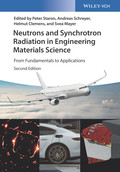Neutrons and Synchrotron Radiation in Engineering Materials Science
From Fundamentals to Applications

2. Auflage März 2017
XXIV, 462 Seiten, Hardcover
284 Abbildungen (73 Farbabbildungen)
27 Tabellen
Handbuch/Nachschlagewerk
Kurzbeschreibung
Retaining its proven concept, the second edition of this ready reference is thoroughly revised and updated, with about 20% new material, to specifically address the need of materials engineers for reliable, detailed information on modern material characterization methods.
Retaining its proven concept, the second edition of this ready reference specifically addresses the need of materials engineers for reliable, detailed information on modern material characterization methods.
As such, it provides a systematic overview of the increasingly important field of characterization of engineering materials with the help of neutrons and synchrotron radiation. The first part introduces readers to the fundamentals of structure-property relationships in materials and the radiation sources suitable for materials characterization.
The second part then focuses on such characterization techniques as diffraction and scattering methods, as well as direct imaging and tomography. The third part presents new and emerging methods of materials characterization in the field of 3D characterization techniques like three-dimensional X-ray diffraction microscopy. The fourth and final part is a collection of examples that demonstrate the application of the methods introduced in the first parts to problems in materials science.
With thoroughly revised and updated chapters and now containing about 20%
new material, this is the must-have, in-depth resource on this highly relevant topic.
Microstructure and Properties of Engineering Materials
Internal Stresses in Engineering Materials
Texture and Texture Analysis in Engineering Materials
Physical Properties of Photons and Neutrons
Radiation Sources
PART II. METHODS
Introduction to Diffraction Methods for Internal Stress Analyses
Stress Analysis by Angle-Dispersive Neutron Diffraction
Stress Analysis by Energy-Dispersive Neutron Diffraction
Residual Stress Analysis by Monochromatic High-Energy X-rays
Residual Stress Analysis by White High Energy X-Rays
Diffraction Imaging for Microstructure Analysis
Basics of Small-Angle Scattering Methods
Small-Angle Neutron Scattering
Decomposition Kinetics in Copper-Cobalt Alloy Systems: Applications of Small-Angle X-ray Scattering
B3 Imaging
Neutron and Synchrotron-Radiation-Based Imaging for Applications in Materials Science - From Macro- to Nanotomography
Micro-Tomography of Engineering Materials
Diffraction Enhanced Imaging
PART III. NEW AND EMERGING METHODS
3D X-ray Diffraction Microscope
3D Micron-Resolution Laue Diffraction
Quantitative Analysis of Three-Dimensional Plastic Strain Fields Using Markers and X-ray Absorption Tomography
Research with Neutron and Synchrotron Radiation on Aerospace and Automotive Materials and Components
In Situ Experiments with Synchrotron High-Energy X-Rays and Neutrons
Application of Photons and Neutrons for the Characterization and Development of Advanced Steels Contribution of High-Energy X-Rays and Neutrons to Characterization and Development of Intermetallic Titanium Aluminides
In Situ micro-Laue: Instrumental Setup for the Deformation of Micron Sized Samples
Multilayer Systems for Cutting Tools
Born in 1963, Andreas Schreyer studied physics and geophysics at the Ruhr-Universität Bochum, gaining his doctorate in 1994 and his lecturing qualification in 2000. In 2001 he became Professor at the University of Hamburg and the head of the Department Materials Characterization with Neutron and Synchrotron Radiation at the Helmholtz-Zentrum Geesthacht. From 2006 to 2016 he was head of the Institute of Materials Research at the Helmholtz-Zentrum Geesthacht responsible for Materials Physics. Between 2008 and 2015 Professor Schreyer has been the spokesperson of the Helmholtz Program "From Matter to Materials and Life" of the Helmholtz Association coordinating all activities in the field of large-scale facilities for synchrotron radiation, neutrons, ions, and highest electromagnetic fields.
In 2016 he moved to the European Spallation Source in Lund, Sweden, where he is the Director for Science.
Born in 1957, Helmut Clemens studied materials science at the Montanuniversität Leoben, Austria, gaining his doctorate in 1987. He joined Plansee AG, Austria, as head of the Advanced Materials R&D group in 1990, gaining his lecturing qualification in 1997. From 1998 to 2000 he was Professor for Metallic Materials at the Institute for Physical Metallurgy, University of Stuttgart, before moving to the Institute for Materials Research, Helmholtz-Zentrum, Geesthacht, in a joint appointment as Professor at the University of Kiel. Since July 2003 he is head of the Department of Physical Metallurgy and Materials Testing at the Montanuniversität Leoben. Professor Clemens has won several awards, including the prestigious Honda Prize.
Born in 1981, Svea Mayer studied materials science at the Montanuniversität Leoben, Austria, and received her PhD in 2009. Since then, she is leading the working group on phase transformations and high-temperature materials at the Department of Physical Metallurgy and Materials Testing, Montanuniversität Leoben. In 2011 she was accepted as assistant professor and started lecturing. Her prime research topic is the use of neutrons and synchrotron radiation for the development of novel high-temperature materials.
She is member of review panels and for her academic achievements she was awarded with the Georg-Sachs-Prize of the Deutsche Gesellschaft für Materialkunde e.V.


